
| Sanskrit Pronunciation | Skandasana (SKAHN-dahs-uh-nuh) |
| Which means | Skanda = Warrior / Asana = Pose |
| Pose Kind | Facet Lunge, Hip Opener |
| Pose Stage | Intermediate to Superior |
| Anatomy | Hips, glutes, hamstrings, quadriceps, knees, ankles |
| Different Names | Facet Lunge Pose, Warrior’s Lunge, Skanda Pose |
Skandasana, also referred to as the Facet Lunge Pose, is a dynamic yoga posture that considerably enhances decrease physique flexibility, power, and mobility. Focusing on the hips, glutes, hamstrings, and quadriceps, this pose is a key part of any hip-opening sequence. Whether or not built-in right into a yoga circulation or practiced independently, Skandasana offers a deep stretch whereas difficult stability and stability, making it each bodily rewarding and mentally participating.
Incorporating Skandasana into your routine builds decrease physique power and improves total stability and alignment. This dynamic pose promotes conscious motion, boosting physique consciousness and coordination. As you shift your weight from one leg to the opposite, Skandasana not solely stretches and prompts tight muscle mass but additionally tones them, enhancing flexibility and resilience in every day actions.
Which means
In Skandasana, the time period “Skanda” refers to a warrior‘s place throughout an assault, and “asana” means “pose.” This pose is devoted to Kartikeya, the elder son of Lord Shiva and the god of battle. The facet lunge place of Skandasana resembles a battle-ready stance, evoking the picture of a warrior getting ready for fight. As such, the pose is also referred to as the “pose of the battle god,” reflecting its sturdy, assertive stance and its affiliation with martial power and readiness.
Mythology
In response to the epic poem Kumarsambhava by Kalidasa, the demon Taraka was inflicting nice disturbance among the many gods. He had acquired a boon that he might solely be killed by the son of Lord Shiva. To handle this, Goddess Parvati approached Shiva, who was deep in meditation. To disrupt Shiva’s meditation, Kama (the god of affection) shot an arrow of need at him, which resulted in Kama being diminished to ashes when Shiva opened his third eye.
To reconcile with Shiva, Parvati embraced asceticism and non secular self-discipline, in the end marrying him. Finally, their son Kartikeya (Skanda) was born. Upon reaching manhood, Kartikeya fulfilled the prophecy by defeating and destroying the demon Taraka.
Skandasana(Facet Lunge Pose) apply information
Skandasana provides a dynamic stretch and strength-building alternative for the decrease physique. Right here’s a information on safely apply Skandasana, together with preparatory poses, steps, suggestions, precautions, contraindications, follow-up poses, and variations.
Preparatory pose
Learn how to do skandasana(steps)

- Stand together with your toes huge aside, about three to 4 toes, and barely flip your toes outwards.
- Shift your weight onto your proper foot, bending your proper knee whereas maintaining your left leg straight and the toes pointing upwards.
- Decrease your hips down and again, making a deep lunge together with your proper leg, and maintain your left leg prolonged.
- Place your fingers on the ground in entrance of you for stability or use yoga blocks. Alternatively, convey your fingers to a prayer place (Anjali Mudra) at your chest.
- Interact your core muscle mass to keep up stability and maintain your torso upright with relaxed shoulders.
- Maintain the pose for a number of breaths, specializing in the stretch in your interior thighs and groin whereas sustaining regular respiration.
- Slowly return to the beginning place and repeat the identical steps on the other facet.
- After training on either side, return to a standing place together with your toes collectively, taking a second to note the results of the pose.
Freshmen suggestions
- Place yoga blocks beneath your fingers for help for those who discover it difficult to achieve the ground, serving to with stability and alignment.
- Guarantee your bent knee is straight above your ankle and maintain your toes hip-width aside with toes barely turned outwards.
- Actively have interaction your core muscle mass to assist stabilize your torso and preserve stability all through the pose.
Precautions
- Keep away from letting your bent knee prolong past your toes to stop pressure on the knee joint
- Hold your again straight and chest lifted to keep away from collapsing or rounding your backbone.
- Guarantee your weight is evenly distributed to stop overloading one facet and to keep up stability.
- Don’t drive your self right into a deep lunge for those who really feel discomfort; work inside your vary of movement and use props if wanted.
- Hold the prolonged leg engaged and the foot flexed to guard the hamstring and preserve alignment.
Contraindications
- Keep away from the pose if in case you have current or continual knee accidents, because the deep lunge can pressure the knee joint.
- Chorus from training if in case you have hip accidents or situations that restrict hip flexibility, as it could exacerbate discomfort.
- Skip the pose if in case you have decrease again points or herniated discs, because the place might place undue stress on the decrease again.
- Keep away from if you’re pregnant or have any situations that have an effect on stability and stability, because the pose might be difficult and should have an effect on your middle of gravity.
Comply with up poses
Skandasana Variations
Within the sequence of lunge pose, poses like Equestrian Pose, Low Lunge Pose and Excessive Lunge Pose might be practiced.
Facet lunge variations consist of various place of arms and higher trunk that may be practiced in following method:
1. Utthita baddha parsva upvesasana (Sure facet lunge stretch pose)

On this variation of facet lunge pose, arms are wrapped across the bent leg so it bounds legs and deepens the other leg stretch. To do that:
- From the achieved facet lunge pose (described above), clasp your left wrist or just your fingers together with your proper hand whereas wrapping your proper leg’s shin bone. Hold your left foot pointing upwards and your gaze directed to the left.
2. Standing facet lunge with ahead bend
For this variation, after reaching the ultimate place of the facet lunge pose, straighten your trunk after which bend ahead out of your waist. On this place, your fingers can relaxation in your legs or on the ground.
Props and modifications
- One can put a folded blanket beneath the heel to offer the required help to the posture.
- To deepen the stretching practitioners can stability the pose on the balls of the foot; as if unable to achieve there with the only.
- Practitioners may also place a block beneath their seats to keep away from falling as a consequence of disbalance.
Skandasana advantages
Skandasana improves flexibility within the hips and legs, strengthens the decrease physique, and enhances stability. Common apply builds core stability and helps total motion. These advantages result in higher bodily efficiency and every day performance.
- Enhances Decrease Physique Flexibility: Skandasana deeply stretches the hips, hamstrings, and groin. This elevated flexibility in these areas helps enhance total mobility, making on a regular basis actions like squatting and bending simpler and extra fluid.
- Strengthens Leg Muscle tissues: Holding the facet lunge place engages and strengthens the quadriceps, glutes, and hamstrings. This elevated power helps help higher posture and stability in numerous actions, lowering the danger of damage.
- Improves Stability and Stability: Balancing in Skandasana challenges your core and stabilizing muscle mass. Enhanced stability and stability are essential for actions that require coordination and precision, they usually contribute to raised total physique management.
- Will increase Hip Mobility: The pose opens and stretches the hip joint, which may alleviate tightness and discomfort within the hips. Improved hip mobility helps higher alignment and reduces the danger of accidents associated to restricted motion.
- Stimulates Circulation: The dynamic nature of Skandasana helps stimulate blood circulation to the decrease physique. Improved circulation helps higher muscle restoration and total cardiovascular well being.
- Enhances Core Energy: Partaking the core muscle mass to keep up stability and stability in Skandasana strengthens the stomach muscle mass. A powerful core helps higher posture, reduces again pressure, and improves total purposeful power.
- Improves Joint Alignment: Skandasana helps to align the knee and ankle joints correctly when carried out with appropriate type. Correct alignment reduces the danger of joint ache and discomfort, particularly for people with earlier accidents.
- Balances Sacral and Root Chakras: Skandasana influences the Sacral and Root Chakra, that are related to emotions of safety, stability, and pleasure. Balancing these chakras by the bodily apply of the pose can improve your sense of grounding and well-being.
Conclusion
Skandasana, or Facet Lunge Pose, is a precious addition to any yoga apply, offering vital advantages for each the physique and thoughts. By concentrating on the hips, glutes, hamstrings, and quadriceps, this pose enhances decrease physique flexibility, strengthens core muscle mass, and helps joint well being. Its dynamic nature improves stability and stability whereas selling conscious motion and physique consciousness.
Common apply of Skandasana can result in elevated flexibility, diminished stress, and higher respiratory perform. Moreover, it opens the hip joints and balances key power facilities, contributing to total bodily and psychological well-being. Integrating Skandasana into your routine will help develop a extra versatile, sturdy, and grounded physique, whereas fostering a peaceful and centered thoughts.
Skandasana FAQs
Maintain Skandasana for about 20-30 seconds on both sides, or longer if comfy. Give attention to sustaining stability and a gradual breath all through the pose.
Use yoga blocks beneath your fingers for help to keep up stability and alignment.
Sure, however newbies ought to use props and give attention to alignment and stability. Progressively work into the pose as flexibility and power enhance.
Sure, it stretches the interior thighs, hamstrings, and hips, which improves total flexibility.
Keep away from letting your bent knee prolong past your toes, rounding your again, or putting extreme weight on one facet.
It’s usually not really useful throughout being pregnant as a consequence of stability challenges. Seek the advice of with a healthcare supplier for appropriate modifications.
Incorporate Skandasana into your routine 2-3 occasions every week to boost flexibility, power, and stability.
In Skandasana, the heel of the bent leg is often stored down on the ground to make sure stability and deepen the stretch. Nonetheless, for a extra superior variation, you possibly can raise the heel barely or stability on the ball of the foot to extend the stretch.